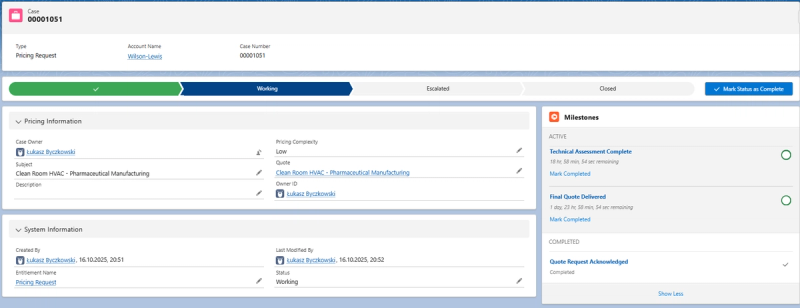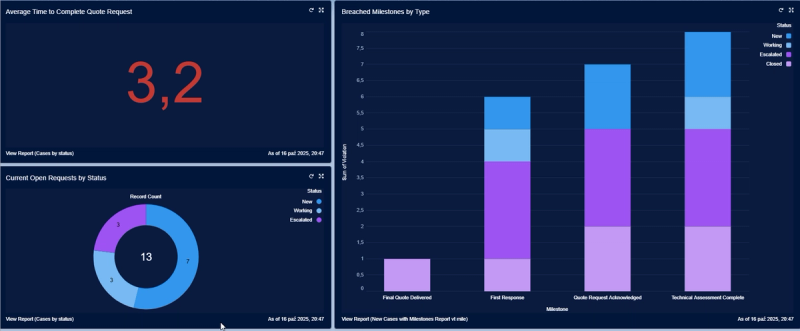Tracking Internal SLAs in Salesforce
Quick Summary
Sales teams can't close deals without support from other departments, but when pricing, engineering, or proposal teams work too slowly, sales reps are left empty-handed in front of customers. This article shows how to use Service Cloud's Entitlements and Milestones—typically used for customer SLAs—to track and enforce internal service level agreements between sales and support departments.
Understanding the Problem
In companies that sell complex services like construction projects or engineering solutions, sales reps rarely work alone. They depend on pricing engineers, technical teams, or proposal specialists to create professional quotes that close deals. When these internal teams miss deadlines, sales opportunities go cold.
Most companies establish internal SLAs—commitments like "pricing will deliver quotes within 48 hours"—but struggle to measure compliance. Without visibility, managers can't identify bottlenecks, and teams can't improve their processes.
Service Cloud's Entitlements and Milestones solve this problem. These features are designed to track customer service commitments, but they work equally well for internal departments. By treating your sales team as an "internal customer," you can measure response times, identify delays, and hold support teams accountable.
The Solution: Internal SLA Tracking with Cases and Milestones
Implementation Difficulty: ⭐⭐⭐☆☆ (3/5)
Development Required: Declarative tools with optional automation
How It Works in Practice
From the Sales Rep's Perspective:
When Maria, a sales rep, needs a professional quote for her customer, she clicks a button on her Quote record. This creates a Quote Request case that immediately goes to the engineering team. The system captures all the key details from her Quote — project type, estimated value, customer requirements—so she doesn't have to retype anything.

The request includes specific information the engineering team needs: project scope, special requirements, and when she needs the quote by. Once submitted, Maria can see exactly where her request stands at any moment without sending "just checking in" emails.
From the Engineering Team's Perspective:
The engineering team receives the Quote Request in their queue. They see three clear milestones with countdown timers:
- Quote Request Acknowledged (2-hour target) – Someone on the team takes ownership and confirms they're working on it
- Technical Assessment Complete (24-hour target) – The engineer finishes cost calculations, material sourcing, and feasibility analysis
- Final Quote Delivered (48, 72 or 96-hour total target dependable on pricing complexity) – The formatted, professional quote document is ready and delivered back to sales
As they progress through their work, they mark each milestone complete. If they're running behind, the system alerts them and their manager before the deadline passes. When the quote is finished, Maria gets an automatic notification with the completed document attached.
The Business Workflow:
The entire process is tracked as a Case linked to the original Quote. This means all communication, documents, and timeline history stay connected to the deal. If Maria needs to reference why a quote took longer than expected, or if her manager wants to review the team's workload, everything is documented in one place.
Service Level Agreements in Action:
The system enforces your internal SLAs automatically. If the engineering team consistently completes quotes in 36 hours, that's great. If quotes regularly breach the 48-hour target, managers see this immediately in their dashboard and can investigate why—are requests unclear? Is the team understaffed? Do certain project types take longer?

The key difference from informal commitments: these SLAs are measured, visible, and actionable. Both departments can see the same data and have productive conversations about improvement.
Dashboard for Sales and Engineering Leaders
Create a dashboard that both the Head of Sales and Head of Engineering review weekly. Include these components:
Key Metrics:
- Average Time to Complete Quote – Are we getting faster or slower?
- SLA Compliance Rate – What percentage of pricing requests meet all milestone deadlines?
- Current Open Requests by Stage – Where are requests getting stuck right now?
Bottleneck Analysis:
- Time Spent at Each Milestone – Which stage takes the longest? (Chart showing average hours for each milestone)
- Breached Milestones by Type – Are we consistently missing the same milestone?
Team Performance:
- Quote Requests by Sales Rep – Who's creating the most requests?
- Completion Rate by Engineer – Which team members are most efficient?
- Trend Over Time – Line chart showing SLA compliance month-over-month
Operational Insights:
- Quote Requests by Project Type – Do certain types take longer?
- Peak Request Times – When does the engineering team get overwhelmed?

This shared dashboard creates accountability on both sides. Sales leaders can see if their team is submitting clear, complete requests. Engineering leaders can identify capacity issues before they impact sales performance.
Key Benefits
For Sales Teams:
- Visibility into where their quote request stands
- Data to push back when deadlines aren't met
- Faster quote turnaround means faster deal closure
For Engineering/Pricing Teams:
- Clear expectations about response times
- Recognition when SLAs are consistently met
- Data to justify additional resources or process changes
For Leadership:
- Objective metrics to evaluate cross-department collaboration
- Early warning system for capacity problems
- Foundation for continuous process improvement
Important Considerations
- Service Cloud License Required: Entitlements and Milestones require Service Cloud. Check your licensing before implementing.
- Start Simple: Begin with one internal process (like quotes) before expanding to other departments.
- Review SLA Targets Regularly: Your initial time targets may need adjustment based on real-world data.
- Cultural Change: This works best when both departments view it as a partnership tool, not a punishment system. Frame it as process improvement, not performance management.
